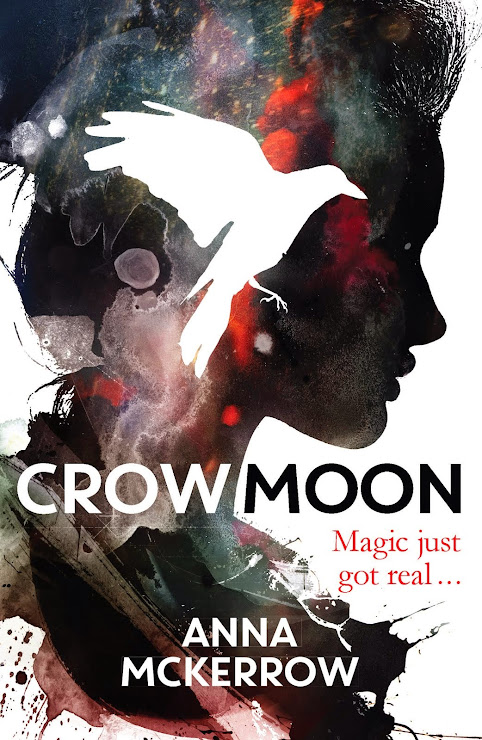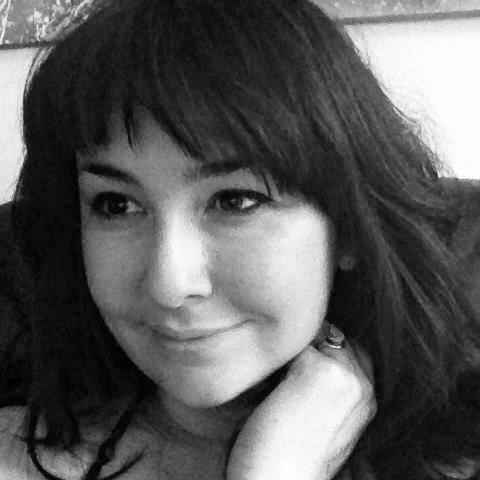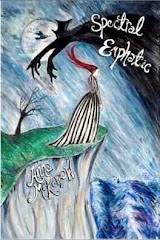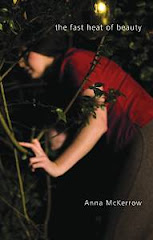I haven't written an academic essay for a few years now, and writing a lot of Young Adult fiction kind of rewires your brain in completely another way. In 2008 this is what I was thinking about. Quite frankly, I am both impressed at my own academic loquaciousness and utterly confused about what it all means.
Using a detailed range of examples, discuss the
relationship between the materialities of digital poetics and that of the book
and / or recent and current writing practice. Try to refer to how your own
practice and practical interests relate to these issues.
Like any medium, the realm of digital
poetics houses and implicates its own particular structures and requirements
for writing. As Loss Glazier discusses in Digital
Poetics, from this point of view, the internet and/or the digital forum is
no different to the “new” development of the medium of film or that of the
novel in its time; we are, therefore, tasked with finding ways to critique and
understand the way writing, specifically poetry, works in this new form.
In this essay I will look at the following
issues engendered by a study of digital poetics and how they relate to the
materiality of poetry: the notion of materiality being the physical, and the
relationship between the body and the text as a body; the philosophy of the
link; dynamism; the role of the author and the philosophical issues of
cyberspace and the infinite. I will also look at my own work in relation to
these issues.
Using digital poetry as a medium
consists of a wealth of considerations. Instead of putting pen to paper and
making a permanent mark, one is manipulating identical and standardised
magnetic marks on a screen. What consequences does this have? It makes the text
potentially interactive and constantly changeable. It means there is no
“original” version – every version of the work is in a sense the original, as
the work is re-imaged and reactivated every time by a different user at a
different time. If published online on the internet, it means millions of
people have instant access to it and it can be written online – writing while
your audience watches. It is dynamic in the sense it can be animated to move,
change colour and link to sound and image.
Glazier considers poetry to be a
particularly suitable form for modern, innovative poetry because of poetry’s
avoidance of the traditional omnipotent “I” of narrative. Rather, its concern
with the multiple in discourse connects with the “polysemous, constantly
changing multiple-author text known as the web,” (Digital Poetics, p22). In discussing the character constructs of
William Gibson’s Neuromancer where at least one character has a cyberspace
existence rather than one of “form”, N Katherine Hayles also refers to the
ability of digital text to foreground the medium and the fictionality of
traditional forms:
“The displacement of presence by
pattern thins the tissue of textuality, making it a semi-permeable membrane
that allows awareness of the text as an informational pattern to infuse into
the space of representation,” (How We
Became Posthuman, p40)
Glazier
also notes that Jerome McGann considers poetry to be particularly conversant
with the digital form because:
“The
object of poetry is to display the textual position. Poetry is language that
calls attention to itself, that takes its own textual activities as its ground
subject,” (Jerome McGann quoted in Digital
Poetics, p21). Similarly, Glazier notes that “language is a procedure to
reveal the working of writing,” (p32).
As Marshall McLuhan said in Understanding Media – The Extensions of Man,
“the medium is the message”. This has a strong relevance to the understanding
of digital poetry, as McLuhan considered the medium of a message more important
than its perceived “meaning”. For instance, that what is shown on television is
unimportant; it is television’s impact on our lives as a medium that is
profound. He also thought that the particular medium that an individual
experienced a particular content through would inevitably influence the
understanding of that content. Modern poetic practice has a strong emphasis on
form and the relevance of materiality on the content of the poem – so much so
that, at best, the poem is its process and vice versa, and to ignore the
aspects that engineer the poem is to wilfully suspend oneself in the erroneous
sense of belief.
Modern poetry prefers to be explicit
about its terms and conditions, and does not expect these to be subsumed
seamlessly by the reader in an attempt to verify the godlike status of the
author and the “essential truth” of the work. Additionally, as Glazier points
out, multimedia does not simply provide an opportunity for convenient
juxtaposition of sources, but for the interweaving of media to create a
harmonious and (somewhat) holistic whole.
The weaving of multimedia sources in
digital poetics is an important aspect of creating a multitudinous text with a
nonlinear narrative. By linking to other sources from your original starting
point, and sometimes by following a seemingly eternal sequence of “doors” in a
labyrinthine journey, the ability of the internet to link from one place to
another is an essential part of the idea that the medium affects the message.
This can be seen in Diane Slattery’s Alphaweb,
where the reader can link from one poem to the next from a series of multiple
choices. Hence, the use of linking presents the reader with a non-predetermined
outcome to their reading experience. As Glazier says, “electronic poems are not
tied to the linearity of the page; this is not an end of linearity but an
emergence of multiple linearities,” (Digital
Poetics, p35).
Glazier also considers the ability to
link to other sources as similar to Freudian parapraxis – when the mind shifts
into an associative disposition and “links” apparently disparate
images/sounds/words together (this could be described as the ultimate aim for a
poet whose goal is to make eternally new associations between sources for the
reader, and express the energy of the work via new expressions and imagery that
have a strong, if unconscious, impact on the reader).
This idea, particularly closely associated
with synaesthesia (a neurologically based phenomenon in which stimulation of
one sensory or cognitive pathway leads to automatic, involuntary experiences in
a second sensory or cognitive pathway – definition on Wikipedia), is something
that has inspired another of my own projects, the Flash Colour Spectrum
project. Briefly, this is a series of 8 panels that follow the human-perceived
colour spectrum (Red, Orange, Yellow, Green, Blue, Indigo, Violet, White) that
individually contain 8 synaesthetic associations/links per page. My aim is to
be able to animate these pages to be able to blend in and out of each other,
both to imitate the spectrum, to question the notion of the spectrum as a
continuum and where one colour starts and another finishes; also to pay a small
homage to Charles Olson’s ideas about energy in a text. This work is literally
about energy – colour is by definition energy vibrating at differing levels.
Overall, again, the medium is the message – associative linking of “object” and
“subject” – the colour and my synaesthetic response to it – and the eternal
circle of the spectrum, which confers a nonlinear text (although not totally
random either).
Jorge Luis Borges’ The Book of Sand is one text that philosophically suggests the
infinite sense of the internet, and also explores the threatening notion of a
book without end where each page is always different and where the reader can
never reassure themselves by returning to the beginning or any familiar
previous page. In the story, the protagonist becomes so afraid of the book that
he hides it away from another discovery. The multiplicity it contains is
disturbing to him, and the threat of an eternally nonlinear “narrative” haunts
Borges. This, it can be said, describes somewhat the cognitive dissonance that
the reader of contemporary experimental poetry experiences, if accustomed to a
beginning, middle and end and a recognisable structure when reading.
Aside from the interesting reflection
that The Book of Sand precipitated
the internet, an infinite and boundless source of linked pages, the book itself
is the medium of infinity, as it has an infinite number of pages that can never
be returned to. The book is also the message, and the message is the
uncertainty and discomfort of the reader in the face of a lack of conclusion.
The Book of
Sand
is also a fictional book, a book within a book, which itself is a fascinating
paradox that foregrounds the essential falsity of the book as a “realistic”
structure.
The materiality of (traditional) books
and bodies is something that N Katherine Hayles discusses in How We Became Posthuman. Both are forms
of information transmission and storage, incorporate encoding in a material
substrate (the body is material and is “programmed” by DNA; the book is a
physical object and its information is encoded in written form on pages and
bound) and cannot easily be changed/amended/destroyed. Both body and book are a
physical object, and both are a space of representation, or message. Therefore,
Hayles makes the organic link between the body and the message – and present
the realisation that to change one changes the other. Therefore, again, the
medium is the message and vice-versa, because they are linked so inextricably.
I have tried to address this idea of
body/text and message in a new piece of work on DNA. As DNA is the programming
code of the body and computer code, be it HTML or ASCII, is the programming
code of digital poetics, I am interested in how they correlate. My first action
was to look at the existing programming code that lay “under” an entry about
DNA on Wikipedia. I then copied this into a Word document and looked through it
at text that might seem interesting and potentially for use in poetics.
After finding the following list of
commands I thought they might be interesting to use to create a new “poem”, so
I took a 4-line excerpt and used it as a repeating “verse” in a DNA-shaped
image created in Photoshop. The “verse” is the horizontal text; the twisting
vertical text was the following text also taken from the original programming
code.
Vertical
text (can be imaged as the verses of the piece):
var stylepath = "/skins-1.5";
var wgArticlePath = "/wiki/$1";
var wgScriptPath = "/w";
var wgScript = "/w/index.php";
var wgServer = "http://en.wikipedia.org";
var wgCanonicalNamespace = "";
var wgCanonicalSpecialPageName = false;
var wgNamespaceNumber = 0;
var wgPageName = "DNA";
var wgTitle = "DNA";
var wgAction = "view";
var wgRestrictionEdit =
["autoconfirmed"];
var wgRestrictionMove = ["sysop"];
var wgArticleId = "7955";
var wgIsArticle = true;
var wgUserName = null;
var wgUserGroups = null;
var wgUserLanguage = "en";
var wgContentLanguage = "en";
var wgBreakFrames = false;
var wgCurRevisionId = "169270727";
var stylepath =
"/skins-1.5";
var wgArticlePath
= "/wiki/$1";
var wgScriptPath
= "/w";
var wgScript =
"/w/index.php";
var wgServer =
"http://en.wikipedia.org";
var
wgCanonicalNamespace = "";
var
wgCanonicalSpecialPageName = false;
var
wgNamespaceNumber = 0;
var wgPageName =
"DNA";
var wgTitle =
"DNA";
var wgAction =
"view";
var
wgRestrictionEdit = ["autoconfirmed"];
var
wgRestrictionMove = ["sysop"];
var wgArticleId =
"7955";
var wgIsArticle =
true;
var wgUserName =
null;
var wgUserGroups
= null;
var
wgUserLanguage = "en";
var
wgContentLanguage = "en";
var wgBreakFrames
= false;
var
wgCurRevisionId = "169270727";
Horizontal
text (can be imagined as the chorus of the piece):
<li
class="toclevel-2"><a href="#Major_and_minor_grooves"><span
class="tocnumber">1.1</span> <span
class="toctext">Major and minor
grooves</span></a></li>
<li
class="toclevel-2"><a href="#Base_pairing"><span
class="tocnumber">1.2</span> <span
class="toctext">Base pairing</span></a></li>
<li
class="toclevel-2"><a href="#Sense_and_antisense"><span
class="tocnumber">1.3</span> <span
class="toctext">Sense and
antisense</span></a></li>
<li
class="toclevel-2"><a href="#Supercoiling"><span
class="tocnumber">1.4</span> <span
I liked the repetition of these
intriguing terms, which although generated from code, present a massive arena
of interpretation, onomatopoeic dynamism (“coiling” “pairing”) and even
self-referential irony, (“sense and antisense”). They have poetic qualities
because of their use of repetition of words, each time slightly customised for
the purpose of the particular line. Additionally, using this kind of
data-as-poetic-text opens up the potential to use the programming code’s use of
special characters as a dynamic form of punctuation, guidance for reading and
for breath (i.e., >< could be
interpreted by a reader as a pause)– as in
Charles Olson’s famous essay, Projective
Verse. You can see the finished result on my attached image.
However, this is the first part of my
considerations of DNA, and in particular I became interested with the
potentially generative aspects of working with this embodied code. In genetics
and when creating a new gene, a new DNA code made of two “ladders” of protein
code is “zipped” up together to make a complete gene. This thought gave me my
first idea of being able to animate a DNA poem in Flash, so that two “ladders”
of randomly generated words from computer code, a little like the above
vertical text example, could be zipped up on-screen and generate a poem.
From this desire to make generative
work based on the idea of DNA and code (on which premise a very interesting
work by Andreas Muller-Pohle is based, Blind
Genes (2002), cited in Digital Art by
Christiane Paul), I progressed onto an idea inspired by genetic engineering. In
the process of making a new gene, half a new gene (one “ladder”, if you like)
is dipped into a bowl containing a “soup” of proteins – always C, G, A and T
(Cytozine, Guanine, Adenine and Thymine, respectively). The molecules bond to
the existing structure and a new gene is made. Additionally, Adenine and
Thymine always bond together, as do Cytozine and Guanine. So, from a poetic
mindset, you can see that C and G together and A and T together make a subset
of potential poetry code.
From a generative point of view and
using the image of the bowl of protein (word) soup, I next imaged a stage of
the project where, rather like William Burroughs’ cutup method (, I could place
20 random words beginning with C and 20 random words beginning with G in a bowl
and pull them out, ordering them into a randomised “zip”, according to which
words came out in what order, only making sure that each line had a linked C
and G. This process also has the potential to be animated, both in the zipping
up and in the random generation.
In this work and in the work of
genetics, to change the message is to change the medium (to link back to
Hayles), especially if the change in the “message” (encoding) refuses to make
the usual links between C and G, A and T. The medium (gene) will become mutated
if a different encoding process is followed. Hayles discusses the notion of
mutation as something that distorts a pattern in information, after the theory
of informatics: that information is identified with choices that reduce
uncertainty. Where mutation occurs, there is also a jump-off point for text to
go in a new direction. In the arena of modern poetics, this supports the aims
of making-strange and unfamiliarity in avant-garde processes used to create and
present poetry. Mutation makes something new:
“The catastrophe in the
pattern/randomness dialectic… a rupture of pattern so extreme that the
expectation of continuous replication can no longer be sustained,” (Posthuman, p33)
Loss Glazier discusses the notion of
“seams” he found in the world of the digital through its being of one language
being combined with another – computer code mixed with “recognised” language.
Marjorie Perloff decribed Charles Bernstein’s work as:
“..playfully exploits pun, anaphora,
epiphora, metathesis, epigram, anagram and neologism to create a seamless web
of reconstituted words” (Digital Poetics,
p36)
It is not too much of a leap to
consider a zip a seam – a thing that joins – and Glazier confirms that poetic
language “is a seam through which seep multiple parts of language” (p38). Hence
the materiality of this work directly reflects its message, and vice-versa: the
concept of the code-forming structure of DNA is described through the action of
its generation. The message is how the body (text) is formed; the medium shows
it being formed. The final “content”, in terms of the actual line-up of the C
and G words, in line with McLuhan, is almost irrelevant (it would be different
every time if accessed via a (reasonably) random online word-generator). All
that is important is that poetic language has been created via the seam that
joins multiple parts of language.
*
Where the poem on the page written by
hand could be said to contain an idiosyncratic “essence” of the writer, when
the work produced is channelled through the ownership vector (reference: Wark, The Hacker Manifesto) of the publication
process, the reader is dissociated from the author and the author is removed
from the production process. Not so with the digital realm for the poet, as
this is somewhere she can produce and publish instantly online for immediate
consumption. Immediacy, a multitextual approach and use of multiple linearities
are some of the methods that characterise the energy that animates digital
poetry and helps return poetry to its original reason for being, like all art –
to challenge and develop existing modes of expression. Recognition of the
material structures that “meaning” rests on – or recognising that meaning is
articulated by those structures – seems essential for the development of poetry
as a form, and by wider implication, serves the study of social structures and
an understanding of the (frustratingly) complex sense that there are no
definitives and no full stops in our daily, fractured experience.
Anna
McKerrow
2592
words
Bibliography
Bibliography
De
Giovanni, Norman Thomas (trans) and Clarke, Maximus, The Book of Sand: A Hypertext Puzzle http://artificeeternity.com/bookofsand/
Glazier,
Loss Pequeno, Digital Poetics: The Making
of E-Poetries, The University of Alabama Press, (Tuscaloosa and London,
2002)
“William
Burroughs and the Composite Text”, Oliver Harris (2007) on
www.realitystreet.org, http://realitystudio.org/scholarship/cutting-up-the-archive-william-burroughs-and-the-composite-text/
Hayles,
N Katherine, How We Became Posthuman:
Virtual Bodies in Cybernetics, Literature and Informatics, University of
Chicago Press, (London 1999)
Olson,
Charles, “Projective Verse” in Selected
Writings of Charles Olson, eds Robert Creeley (1950, New York)
Paul,
Christiane, Digital Art, Thames &
Hudson World of Art. (London, 2003)
Slattery,
Diana Reed, Alphaweb, http://iat.ubalt.edu/guests/alphaweb/
Wark,
Mackenzie, The Hacker Manifesto http://subsol.c3.hu/subsol_2/contributors0/warktext.html





